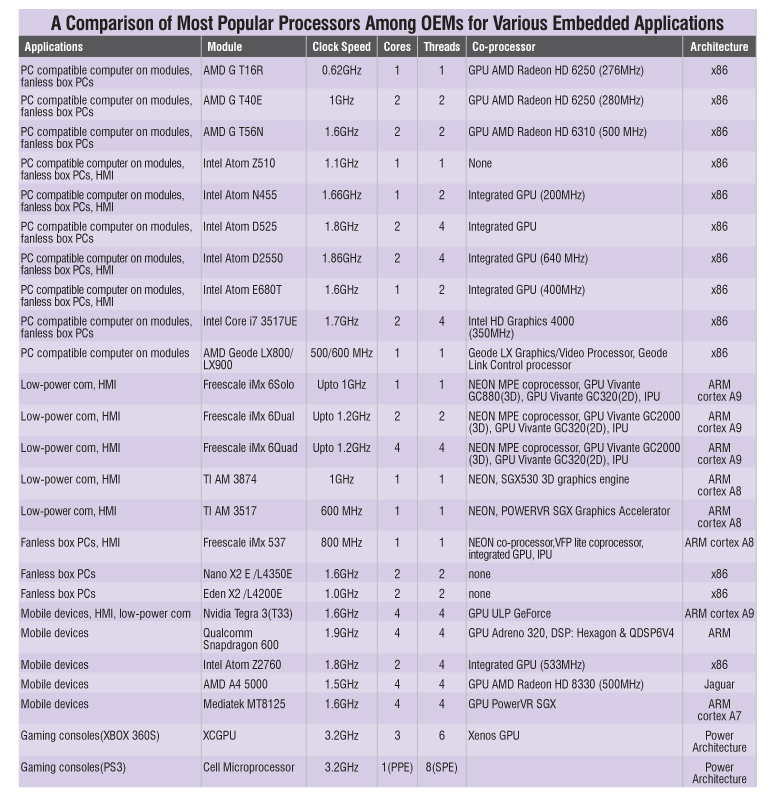Selecting a processor for embedded designs
Advent of different processor architectures has led to development of many application-specific processors. This section gives you an insight on selection of the correct processor based on the application for which it is required.
Another development worth noting in the Indian chip design scene is the indigenous SoC designing being done by firms such as Sankhya Technologies and Dreamchip to develop a ready-to-use synthetic processor and SoC platform for major markets. “These allow the designers to make optimal hardware and software trade-offs that gain them the flexibility of software and the performance of hardware, which any embedded system design house would love to have,” explains Gopi Kumar Bulusu, chief technologist at Sankhya Technologies.
Table in the next page provides a comparison of the most popular processors that are being used by OEMs for various embedded applications.
PC-compatible CoMs
Computer on module, or COM, is a compact, high-performance system designed to focus on core competencies. Highly integrated PC-compatible COMs are based on x86 CPU architectures that provide a scalable solution and at the same time meet the advanced CPU application development needs. Some of the widely used x86 architecture processors are listed in the table. From Intel Atom series via AMD designs to Intel core processors, designers have a wide range of processors to select from, for designing their COMs.
While single-core processors from Intel Atom series like N270, N455 and Z510 are more focussed on balance in power consumption, performance and pricing, newer AMD G-series processors provide new graphic performance on user-friendly interfaces or HD video onto the designs in single as well as dual-core options. AMD G-series with its 40nm technology vs Intel’s 45nm technology provides a powerful yet cooler design. If you are going for a design with low-power consumption, Intel Atom Z510/N270 is the option to be locked, while if you need higher graphic performance in your designs, AMD G-series will fit best.
Low-power COMs
COMs that are specifically designed for high performance in low-power envelope are based on ARM processors, but other low-power ×86 architectures could also be used. ‘SMARC’ or ‘Smart Mobility ARChitecture’ is a specification by the Standardisation Group of Embedded Technologies for such COMs.
ARM architecture-based processors are built with fewer transistors than other traditional x86 processors, resulting in reduced cost, heat and power usage. This makes them a perfect fit for the low-power COM designs. ARM Cortex A9-based i.Mx 6 family from Freescale is an example that supports a wide range of applications with its single, dual and quad core offerings.
Fanless box PC
The design of fanless box PCs used for various machine-controlled industrial applications is focussed on harsh environmental conditions and factory usage; however, they can also be designed for graphic-oriented applications like digital signage and media playback.
AMD G-series is a good option for graphic-oriented designs. Intel Atom series processors are good for robust low-power applications with a wide range of processor speeds to choose from. Apart from Intel Atom series and AMD G-series, VIA Nano X2 E and Eden E series are other dual-core series of processors that can be taken into account while designing fanless systems. X86 architecture-based Nano and Eden series have 40nm manufacturing technology and can withstand a wide range of temperatures due to their design.

Human machine interface (HMI)
HMIs in industrial designs handle human-machine interactions. These can vary from simple switches, keypads to touchscreens and panel PCs. Most of the HMI solutions in the market are x86 based, using processors from Intel and other manufacturers that provide performance and flexibility. Industrial HMI requirements are increasing the need for greater processing performance and more interface supports, and at the same time maintaining minimum heat generation and compact size, which is contributing towards use of ARM processors for HMI designs.
Future ahead
Every now and then, newer versions of chips are released, however when the time comes for an upgrade, future expandability is a very important factor. Gordon Moore saw an end to processor speed growth when he said, “We can’t exceed the speed of light,” back in 1998. Rather than focussing on high speed, a smart engineer needs to focus on optimum speed, which can be sustained.
Pankaj V. is a technical journalist at EFY Gurgaon, while Dilin Anand is senior technical correspondent at EFY Bengaluru








